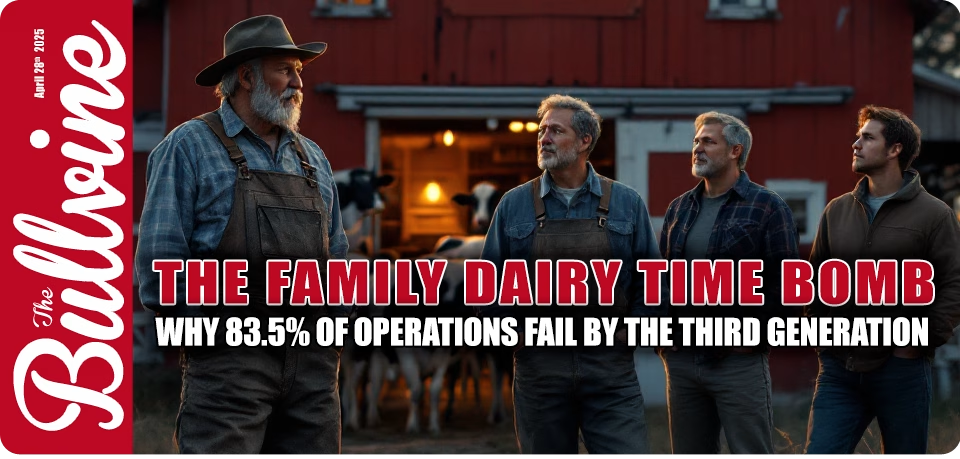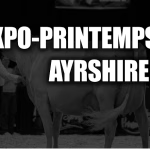Latest News
Ice at the Gate: Why Dairy’s “Head-In-The-Sand” Approach is a Recipe for Disaster
ICE visits can cripple your dairy overnight. Discover the 9-word phrase and compliance hacks that keep your crew milking and fines at bay. Let's face it: Most d […]CME Dairy Market Report – April 28, 2025: Bearish Forecasts and Trade Headwinds
Butter dips amid quiet CME trading as USDA forecasts dairy slump; China tariffs squeeze exports. EXECUTIVE SUMMARY: The CME dairy markets opened the week with m […]The Equipment Paradox: Why Record Auction Prices Aren’t What They Seem
Record used equipment prices aren’t pushing dairy farmers to buy new-discover why economic survival tactics drive their real choices. Tractor working with silag […]Weekly Global Dairy Market Recap April 28th, 2025: Fat Leads the Way While Powders Take a Breather
Global dairy markets clash: Milk fat surges as powders stall. Argentina booms, China buys big, while Australia lags. Who wins? EXECUTIVE SUMMARY: Global dairy m […]Quality Over Quantity: Revolutionary Approaches to Dairy Replacement Management
Healthy replacements are the future of dairy! Learn how smarter management can boost growth, cut costs, and improve herd performance. EXECUTIVE SUMMARY: Dairy r […]
More News
- Midwest Spring National Holstein Show 2025 Crowns New Champions in Madison Showcase
- Protein Sweet Spot: How 160g Crude Protein Maximizes Dairy Farm Profits
- Australian Jersey Excellence Shines: 2025 Sydney Royal Show Spotlights Breed’s Global Potential
- Robotic Milking Revolution: Why Modern Dairy Farms Are Choosing Automation in 2025
- Western Dairy Expo 2025: R&F Livestock Clinches Grand Champion Title with Olortine Avenger Design
- Mind Over Milk: The Gut-Brain Revolution That Will Redefine Dairy’s Value
- Texas A&M Launches $3 Million Study to Track Bird Flu in Dairy Workers
- Holding Onto Cows? It’s Crushing Your Milk Price
- CME Daily Dairy Market Report – April 25, 2025: Butter plunges while cheese barrels rise
- Beyond The Milk Check: Why Your Recognition Strategy Matters More Than Your Breeding Program
Top News Posts from Past Week
- FDA Pulls Plug on Milk Testing: What You Need to Know Now
- The Empire State’s Dairy Revolution: Why New York’s $2.4 Billion Processing Boom Will Force You to Rethink the Industry’s Future
- Mega-Dairy Revolution: Inside the World’s 10 Largest Dairy Farms
- Western Dairy Expo 2025: R&F Livestock Clinches Grand Champion Title with Olortine Avenger Design
- Double-Ovsynch or Double E-Synch? Which Fertility Program Will Boost Your Herd’s Pregnancy Rates?
- Milk Down the Drain: Müller’s Mess Leaves Farmers Fuming on TikTok
- Fonterra’s Fixed Milk Price Hits Record $9.60 as Farmers Rush to Lock in Future Income
- H5N1 Crisis Hits 1,000 U.S. Dairy Herds: California Epicenter and Nevada’s New Viral Threat Demand Immediate Action
- FMD JUMPS CONTAINMENT LINES: New Hungarian Outbreak Signals Dangerous Phase for Dairy Industry
- Dairy Markets: Behind The Numbers of April’s Milk Production Report
Feature Articles
The Family Dairy Time Bomb: Why 83.5% of Operations Fail by the Third Generation
83.5% of dairy farms vanish by the third generation. Is yours next? Discover the hidden math, family dynamics, and strategic fixes to secure your legacy. E241 T […]Roy Ormiston: The Holstein Man’s Holstein Man Who Revolutionized Modern Breeding
How one man's $750 gamble on a white cow created a Holstein dynasty that reshaped global dairy genetics and continues to influence breeding decisions today. E24 […]Cash from Cow Burps: How Dairy Farmers Are Turning Climate Challenges Into $1,200/Head Profit
Dairy farmers slash methane emissions & boost profits by $1,200/head. Discover how climate action drives dairy's sustainable future. E239 Cash from Cow Burp […]Ontario Spring Discovery Holstein Show 2025
April 23rd, 2025 @ Ancaster OntarioJudge: Aaron Eaton, NY USA The Ontario Holstein Spring Show featured exceptional quality across all divisions, with judge Aar […]Ontario Spring Discovery Jersey Show 2025
April 23rd, 2025 @ Ancaster Ontario Judge Blair Weeks INTENSE JOEL OME Grand Champion Ontario Spring Discovery Jersey Show 2025 C DESROSIERS, J & C SICARD, P B […]
More Articles
- From Show Ring Legend to Industry Innovator: The David Dyment Story
- Expo-Printemps 2025 – Ayrshire
- Expo-Printemps 2025 – Jersey
- Expo-Printemps 2025 – Holstein
- Expo-Printemps 2025 – Red & White Holstein
- Hearts of the Heartland: Young Dairy Farm Girls’ Extraordinary Battles for Life
- 5 Powerful Stress-Busting Techniques Every Dairy Farmer Needs This Spring
- Mystic Valley Dairy: The Secret Behind Their Jaw-Dropping 125-Pound ECM Average
- MANURE TO MONEY: How Smart Dairy Farmers Are Turning Waste into Serious Profits
- Hanoverhill Starbuck’s DNA Dynasty: The Holstein Legend Bridging 20th-Century Breeding to Genomic Futures
Top Feature Articles from the Past Month
- Expo-Printemps 2025 – Holstein
- Ontario Spring Discovery Holstein Show 2025
- Northeast Spring National Holstein Show 2025
- Top 15 Best Milk Brands in the USA: Unveiling the Cream of the Crop
- Hanoverhill Starbuck’s DNA Dynasty: The Holstein Legend Bridging 20th-Century Breeding to Genomic Futures
- The Cow That Built an Empire: Comestar Laurie Sheik’s Unstoppable Genetic Legacy
- From Show Ring Legend to Industry Innovator: The David Dyment Story
- Why Donald Trump Hates Canada’s Dairy Supply System
- CAPTAIN: The Bull That Rewrote the Rules for Modern Breeding
- Making Dreams Come True: The Journey of Tom & Kelli Cull
- The Family Dairy Time Bomb: Why 83.5% of Operations Fail by the Third Generation
-
The Family Dairy Time Bomb: Why 83.5% of Operation…
Andrew Hunt Apr 28, 202583.5% of dairy farms vanish by the third generation. Is yours next? Discover the hidden math, family dynamics, and strategic fixes to secure your legacy. E241 The Family Dairy Time Bomb: Why 83.5% of Oper | RSS.com Your dairy legacy has a staggering 83.5% chance of disappearing by the third g… Read More - Roy Ormiston: The Holstein Man's Holstein Man Who Revolutionized Modern Breeding
-
Roy Ormiston: The Holstein Man’s Holstein Man Who…
Andrew Hunt Apr 27, 2025How one man's $750 gamble on a white cow created a Holstein dynasty that reshaped global dairy genetics and continues to influence breeding decisions today. E240 Roy Ormiston: The Holstein Man’s Holstein Man | RSS.com In the heart of Holstein history: Roy Ormiston at his Roybrook Farm office,… Read More
- Cash from Cow Burps: How Dairy Farmers Are Turning Climate Challenges Into $1,200/Head Profit
-
Cash from Cow Burps: How Dairy Farmers Are Turning…
Andrew Hunt Apr 26, 2025Dairy farmers slash methane emissions & boost profits by $1,200/head. Discover how climate action drives dairy's sustainable future. E239 Cash from Cow Burps: How Dairy Farmers Are Tu | RSS.com The dairy industry stands at a critical crossroads in 2025. While facing mounting pressure to r… Read More
- Ontario Spring Discovery Holstein Show 2025
-
Ontario Spring Discovery Holstein Show 2025
Andrew Hunt Apr 23, 2025April 23rd, 2025 @ Ancaster OntarioJudge: Aaron Eaton, NY USA The Ontario Holstein Spring Show featured exceptional quality across all divisions, with judge Aaron Eaton consistently emphasizing balanced frames, dairy strength, and structural correctness throughout his evaluations. UP-RID… Read More
- Ontario Spring Discovery Jersey Show 2025
-
Ontario Spring Discovery Jersey Show 2025
Andrew Hunt Apr 23, 2025April 23rd, 2025 @ Ancaster Ontario Judge Blair Weeks INTENSE JOEL OME Grand Champion Ontario Spring Discovery Jersey Show 2025 C DESROSIERS, J & C SICARD, P BOULET, QC Grand Champion: Intense Joel Ome-ET (Joel), 1st 5-year-old, C Desrosiers, J & C Sicard and P Boulet, QCRe… Read More
- From Show Ring Legend to Industry Innovator: The David Dyment Story
-
From Show Ring Legend to Industry Innovator: The D…
Andrew Hunt Apr 22, 2025David Dyment's evolution from reluctant showman to AG3's "consistency over unpredictability" philosophy reveals dairy's contrarian innovator. E238 From Show Ring Legend to Industry Innovator: | RSS.com When a seven-year-old David Dyment found himself face-down in the dirt on the family farm… Read More
- Expo-Printemps 2025 - Ayrshire
-
Expo-Printemps 2025 – Ayrshire
Andrew Hunt Apr 20, 2025April 18th, 2025 @ Victoriaville QC BAVAROISE PREDATOR RILEY Grand Champion Quebec Spring Ayrshire Show 2025 AMÉLIE HARDY-DEMERS & MARTIN POIRIER, STE-CÉCILE DE LÉVRARD, QC DREAM RIDGE WILLA RAE -ET Intermediate Champion Quebec Spring Ayrshire Show 2025 DREAM RIDGE, BLACKADDAR, HURON… Read More
- Expo-Printemps 2025 - Jersey
-
Expo-Printemps 2025 – Jersey
Andrew Hunt Apr 20, 2025April 18th, 2025 @ Victoriaville QC JOLICHUTES VICTORIOUS BERLINGOT Grand Champion Quebec Spring Jersey Show 2025 JOHNY JACOBS, JAYDEN DOIRON & BRENT SAYLES, QC JOLICHUTES VICTORIOUS BERLINGOT Intermediate Champion Quebec Spring Jersey Show 2025 JOHNY JACOBS, JAYDEN DOIRON & BRENT S… Read More
- Expo-Printemps 2025 - Holstein
-
Expo-Printemps 2025 – Holstein
Andrew Hunt Apr 17, 2025April 17th, 2025 @ Victoriaville QC Grand Champion PIERSTEIN DEVOUR ROSHA Grand Champion Quebec Spring Holstein Show 2025 PIERRE BOULET, MONTMAGNY, QC Grand - PIERSTEIN DEVOUR ROSHA - PIERRE BOULET, MONTMAGNY, QCReserve - JACOBS UNIX CARFUL - FERME JACOBS INC, … Read More
- Expo-Printemps 2025 - Red & White Holstein
-
Expo-Printemps 2025 – Red & White Holstein
Andrew Hunt Apr 17, 2025April 17th, 2025 @ Victoriaville QC STONEHAVEN BELIEVE JASPER Grand Champion Quebec Spring Red & White Holstein Show 2025 CEDARHOLME HOLSTEINS, PAUL HARRIS, MOUNT FOREST, ON GOLDEN-OAKS-I ALTITUDE IREINE Junior Champion Quebec Spring Red & White Holstein Show 2025 BILL MAYO, EDMOND P… Read More
Tanbark Trail
Ontario Spring Discovery Holstein Show 2025
April 23rd, 2025 @ Ancaster OntarioJudge: Aaron Eaton, NY USA The Ontario Holstein Spring Show featured exceptional quality across all divisions, with judge Aaron Eaton consistently emphasizing balanced frames, dairy strength, and structural correctn […]Ontario Spring Discovery Jersey Show 2025
April 23rd, 2025 @ Ancaster Ontario Judge Blair Weeks INTENSE JOEL OME Grand Champion Ontario Spring Discovery Jersey Show 2025 C DESROSIERS, J & C SICARD, P BOULET, QC Grand Champion: Intense Joel Ome-ET (Joel), 1st 5-year-old, C Desrosiers, J & […]Expo-Printemps 2025 – Ayrshire
April 18th, 2025 @ Victoriaville QC BAVAROISE PREDATOR RILEY Grand Champion Quebec Spring Ayrshire Show 2025 AMÉLIE HARDY-DEMERS & MARTIN POIRIER, STE-CÉCILE DE LÉVRARD, QC DREAM RIDGE WILLA RAE -ET Intermediate Champion Quebec Spring Ayrshire Show 2 […]Expo-Printemps 2025 – Jersey
April 18th, 2025 @ Victoriaville QC JOLICHUTES VICTORIOUS BERLINGOT Grand Champion Quebec Spring Jersey Show 2025 JOHNY JACOBS, JAYDEN DOIRON & BRENT SAYLES, QC JOLICHUTES VICTORIOUS BERLINGOT Intermediate Champion Quebec Spring Jersey Show 2025 JOHN […] Expo-Printemps 2025 – HolsteinApril 17th, 2025 @ Victoriaville QC Grand Champion PIERSTEIN DEVOUR ROSHA Grand Champion Quebec Spring Holstein Show 2025 PIERRE BOULET, MONTMAGNY, QC Grand - PIERSTEIN DEVOUR ROSHA - PIERRE BOULET, MONTMAGNY, QCReserve - JACOBS UNIX CARFUL -&nb […]
Expo-Printemps 2025 – HolsteinApril 17th, 2025 @ Victoriaville QC Grand Champion PIERSTEIN DEVOUR ROSHA Grand Champion Quebec Spring Holstein Show 2025 PIERRE BOULET, MONTMAGNY, QC Grand - PIERSTEIN DEVOUR ROSHA - PIERRE BOULET, MONTMAGNY, QCReserve - JACOBS UNIX CARFUL -&nb […]
The Bullvine LLC © 2025 | Terms of Use | Community Guidelines | Privacy Policy |
Manage Consent
To provide the best experiences, we use technologies like cookies to store and/or access device information. Consenting to these technologies will allow us to process data such as browsing behavior or unique IDs on this site. Not consenting or withdrawing consent, may adversely affect certain features and functions.
Functional Always active
The technical storage or access is strictly necessary for the legitimate purpose of enabling the use of a specific service explicitly requested by the subscriber or user, or for the sole purpose of carrying out the transmission of a communication over an electronic communications network.
Preferences
The technical storage or access is necessary for the legitimate purpose of storing preferences that are not requested by the subscriber or user.
Statistics
The technical storage or access that is used exclusively for statistical purposes.
The technical storage or access that is used exclusively for anonymous statistical purposes. Without a subpoena, voluntary compliance on the part of your Internet Service Provider, or additional records from a third party, information stored or retrieved for this purpose alone cannot usually be used to identify you.
Marketing
The technical storage or access is required to create user profiles to send advertising, or to track the user on a website or across several websites for similar marketing purposes.




























